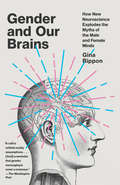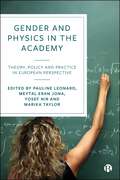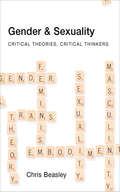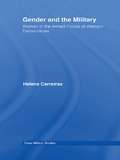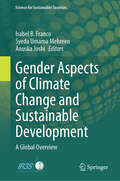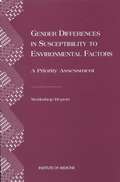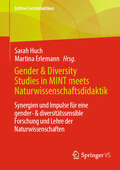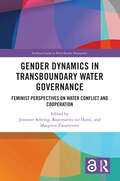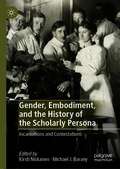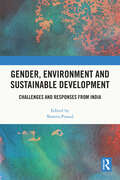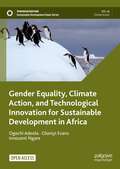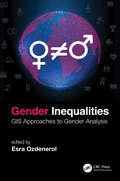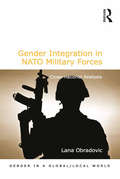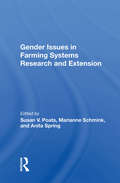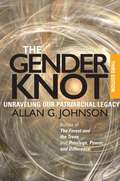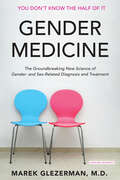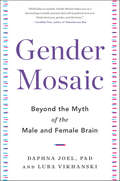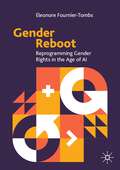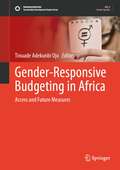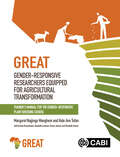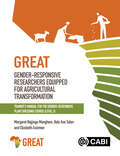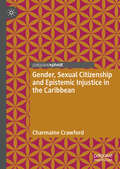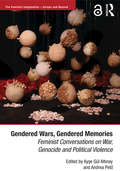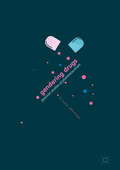- Table View
- List View
Gender and Our Brains: How New Neuroscience Explodes the Myths of the Male and Female Minds
by Gina RipponA breakthrough work in neuroscience and an incisive corrective to a long history of damaging pseudo-science, finally debunking the myth that there is a biological distinction between male and female brains. For decades if not centuries, science has backed up society’s simple dictum that men and women are hardwired differently, that the world is divided by two different kinds of brains—male and female. However, new research in neuroimaging suggests that this is little more than “neurotrash.” In this powerfully argued work, acclaimed professor of neuroimaging, Gina Rippon, finally challenges this damaging myth by showing how the science community has engendered bias and stereotype by rewarding studies that show difference rather than sameness. Drawing on cutting edge research in neuroscience and psychology, Rippon presents the latest evidence which finally proves that brains are like mosaics comprised of both male and female components, and that they remain plastic, adapting throughout the course of a person’s life. Discernable gender identities, she asserts, are shaped by society where scientific misconceptions continue to be wielded and perpetuated to the detriment of our children, our own lives, and our culture.
Gender and Physics in the Academy: Theory, Policy and Practice in European Perspective
by Pauline Leonard, Meytal Eran Jona, Yosef Nir, and Marika TaylorThis innovative interdisciplinary collection confronts the worldwide challenge of women's under-representation in science through an interrogation of the field of physics and its gender imbalance. Leading physicists and sociologists from across Europe collaborate to adopt a comparative approach. They draw on theoretical perspectives and empirical evidence to explore the reasons behind low participation levels, from entering the field to sustaining a career, emphasising the importance of social perspectives over biological explanations. Evaluating policy solutions implemented in various European contexts, this book offers key insights into the world of women physicists and sheds light on their life stories.
Gender and Sexuality: Critical Theories, Critical Thinkers
by Chris BeasleyThis accessible introduction to gender and sexuality theory offers a comprehensive overview and critique of the key contemporary literature and debates in feminism, sexuality studies and men's studies. Chris Beasley's clear and concise introduction combines a wide-ranging survey of the major theorists and key concepts in an ever-growing and often passionately debated field. The book contextualizes a wide range of feminist perspectives, including: modernist, liberal, postmodern, queer and gender difference feminism; and in the realm of sexuality studies covers modernist liberationism, social constructionism, transgender theorising and queer theory. In men's studies, Chris Beasley examines areas of debate ranging from gender and masculinity to questions of race, ethnicity, imperialism and gay masculinities. Interconnections between the subfields are highlighted, and Beasley considers the implications of body theory for all three. Key theorists covered include: Altman· Brod· Butler · Califia· Carbado· Connell· Dowsett ·Grosz· Halberstam· Hook · Jackson· Jagose· Nussbaum· Rich· Seidman· Spivak· Stoltenberg· Weeks· Whittle· Wolf· Wollstonecraft The only book of its kind to draw together all the important strands of gender analysis, Gender and Sexuality is a timely and impressive overview that is invaluable to students and academics taking courses on gender and feminist theory, sexuality and masculinity.
Gender and the Military: Women in the Armed Forces of Western Democracies (Cass Military Studies)
by Helena CarreirasThis is the first comparative, cross-national study of the participation of women in the armed forces of NATO countries. Along side an analysis of this key topic stands a critique of existing theoretical models and the proposal of a revised analytical framework. Unlike previous works this new study employs mixed-methodological research design combining quantitative and qualitative data - a large N-analysis based on general policies and statistical information concerning every country in the sample with more in-depth case-studies. This volume includes original empirical data regarding the presence of women in the armed forces of NATO countries, proposes an index of ‘gender inclusiveness’ and assesses the factors that affect women’s military roles. The book also presents two new key case studies – Portugal and the Netherlands - based on both documentary sources and in-depth interviews of both men and women officers in the two countries. This book will be of great interest to all students and scholars of strategic studies, gender and women studies and military history.
Gender Aspects of Climate Change and Sustainable Development: A Global Overview (Science for Sustainable Societies)
by Isabel B. Franco Syeda Umama Mehreen Anuska JoshiThis book addresses how sustainability discourse and advocacy can translate to impactful policies especially when bridging the divide between sustainability, climate change and gender. The book explores various areas, such as conservation, climate action, sustainable fashion, and corporate sustainability, and defines the existing sustainability gaps in the selected cases (country/sector/region). It highlights the value of sustainability science and climate change on innovative approaches to research, education, capacity-building, and practice to transform rhetoric into impact sustainability while encompassing cases from various industries, sectors, and geographical contexts. While emphasizing SDG 5, the book chapters also show the transboundary implications of gender equality and inclusivity to other sustainable development and climate change goals and targets. The contributions are exemplary in highlighting the relation of gender inclusivity in strengthening efforts to protect andsafeguard the world’s cultural and natural heritage and making cities and human settlements inclusive and safe (Goal 11), protecting, restoring, and promoting sustainable management of terrestrial ecosystems and reverse land degradation (Goal 15), ensuring access to affordable, reliable, sustainable and modern energy for all (Goal 7), promoting sustainable and inclusive economic growth with productive and decent employment for all (Goal 8), promoting inclusive and sustainable industrialization (Goal 9), adopt policies to reduce inequalities (Goal 10), ensure sustainable consumption and production pattern (Goal 12), addressing climate change impacts and building resilience (Goal 13), and ensuring availability and sustainable management of water and sanitation for all (Goal 6).
Gender Differences in Susceptibility to Environmental Factors: Workshop Report
by Committee on Gender Differences in Susceptibility to Environmental FactorsWomen's health and men's health differ in a variety of ways--women live longer on average, for example, but tend to be sicker as well. Whereas some of these distinctions are based solely on gender, there is growing awareness that the environment and related factors may play a role in creating health status differences between men and women. Various factors, such as genetics and hormones, may account for gender differences in susceptibility to environmental factors.In 1996 the Office for Research on Women's Health at the National Institutes of Health asked the Institute of Medicine to conduct a workshop study to review some of the current federal research programs devoted to women's health and to clarify the state of knowledge regarding gender-related differences in susceptibility. This book contains a general outline of research needs, a summary of the workshop proceedings (as well as summaries of the speakers' presentations), and an analysis of the participating federal agencies' research portfolios.
Gender & Diversity Studies in MINT meets Naturwissenschaftsdidaktik: Synergien und Impulse für eine gender- & diversitätssensible Forschung und Lehre der Naturwissenschaften (Edition Fachdidaktiken)
by Martina Erlemann Sarah HuchGender und dessen Zusammenwirken mit weiteren Diversity-Dimensionen wie etwa soziale Herkunft, ein (zugeschriebener) Migrationshintergrund oder sexuelle Orientierung stehen an Hochschulen verstärkt im Fokus. Gefordert sind dabei auch gender- und diversitysensible Ausrichtungen der Forschung und Lehre der MINT-Fächer sowie der hochschulischen Lehramtsausbildung für MINT. Welche inhaltliche Relevanz haben Gender- und Diversity-Aspekte in Fachkultur, Forschungsinhalten sowie im Wissenschaftsverständnis der Naturwissenschaften? Wie strukturieren Geschlecht und andere soziale Differenzkategorien die Forschung? Wie kann eine Gender- und Diversity-Kompetenzen vermittelnde Lehrer*innenbildung aussehen?Auf diese Fragen geben die interdisziplinären Beiträge der Wissenschaftler*innen, etwa aus Physik, Biologie, Medizin, Feminist Science & Technology Studies sowie die naturwissenschaftlichen Fachdidaktiken Antworten. Ansätze sowie Wissensbestände der Gender & Diversity Studies in MINT werden mit den gender- und diversityausgerichteten Naturwissenschaftsdidaktiken zusammengeführt. Mit vielfältigen Anregungen ermutigen sie zu einer gender- und diversityorientierten Ausrichtung der (eigenen) Forschung und Lehre.
Gender Dynamics in Transboundary Water Governance: Feminist Perspectives on Water Conflict and Cooperation (Earthscan Studies in Water Resource Management)
by Jenniver Sehring Rozemarijn ter Horst and Margreet ZwarteveenThis volume assesses the nexus of gender and transboundary water governance, containing empirical case studies, discourse analyses, practitioners’ accounts, and theoretical reflections. Transboundary water governance exists at the intersection of two highly masculinised fields: diplomacy and water resources management. In both fields, positions are mainly held by men, and core ideas, norms, and guiding principles that are presented as neutral, are both shaped by men and based on male experiences. This book sheds light on the often hidden gender dynamics of water conflict and cooperation at the transboundary level and on the implicit assumptions that guide research and policies. The individual chapters of the book, based on case studies from around the world, reveal the gendered nature of water diplomacy, take stock of the number of women involved in organisations that govern shared waters, and analyse programmes that have been set up to promote women in water diplomacy and the obstacles that they face. They explore and contest leading narratives and knowledge that have been shaped mainly by privileged men, and assess how the participation of women concretely impacts the practices, routines, and processes of water negotiations. This volume will be of great interest to students and scholars of water governance, water diplomacy, gender, international relations and environmental politics. It will also be of interest to professionals and policymakers involved in supporting gender mainstreaming in water cooperation.
Gender, Embodiment, and the History of the Scholarly Persona: Incarnations and Contestations
by Kirsti Niskanen Michael J. BaranyThis book investigates the historical construction of scholarly personae by integrating a spectrum of recent perspectives from the history and cultural studies of knowledge and institutions. Focusing on gender and embodiment, the contributors analyse the situated performance of scholarly identity and its social and intellectual contexts and consequences. Disciplinary cultures, scholarly practices, personal habits, and a range of social, economic, and political circumstances shape the people and formations of modern scholarship. Featuring a foreword by Ludmilla Jordanova, Gender, Embodiment, and the History of the Scholarly Persona: Incarnations and Contestations is of interest to historians, sociologists, media and culture scholars, and all those with a stake in the personal dimensions of scholarship. An international group of scholars present original examinations of travel, globalisation, exchange, training, evaluation, self-representation, institution-building, norm-setting, virtue-defining, myth-making, and other gendered and embodied modes and mechanisms of scholarly persona-work. These accounts nuance and challenge existing understandings of the relationship between knowledge and identity.
Gender, Environment and Sustainable Development: Challenges and Responses from India
by Shweta PrasadThis book studies environment and sustainable development from the perspective of gender. It focuses on three major themes, including sustainability of development practices, policy perspectives on environmental management and climate change and its gendered impact. It includes contributions from academicians working across disciplines and practitioners working at the grassroots levels. The book addresses issues facing India amid a growing global environmental crisis and suggests policy measures for environmental protection and to improve the quality of life of its inhabitants. Lucid and topical, the volume will be an indispensable resource for students, researchers of gender, environment and sustainable development, sociology and public policy. It will also be a great resource for advocacy groups, non-governmental organisations (NGOs) and policymakers working in the area.
Gender Equality, Climate Action, and Technological Innovation for Sustainable Development in Africa (Sustainable Development Goals Series)
by Ogechi Adeola Olaniyi Evans Innocent NgareThis open access book explores the intersection of gender and climate change, suggests ways in which innovative technologies can accelerate climate relief actions, and offers strategies for integrating climate change initiatives into national policies and planning. By examining the devastating consequences of climate change on women and girls throughout the continent, the authors pose a crucial question: Does gender matter in climate change discussions in Africa? Political and social traditions have burdened women with greater vulnerability to the impacts of climate-related natural disasters, including violence, displacement, poverty, famine and lack of access to clean water. However, women are also key to effective and inclusive climate mitigation, adaptation, and decision-making. The authors provide a compelling discourse that identifi es the social and economic benefi ts for all citizens when genderinclusive policies shape equitable and targeted action plans, from mitigationto adaptation and funding.The UN’s SDG 13 calls for urgent action and commitment to combat climate change. The implementable and action-oriented propositions presented in this book will be of interest to students, educators, practitioners, third-sector actors, and policymakers committed to gender equality, sustainable development and climate action in Africa.
Gender Inequalities: GIS Approaches to Gender Analysis
by Esra OzdenerolGender inequality is entrenched in the cultural, political, and market systems that operate at household, community, and national levels. Overarching global changes in access to markets, climatic conditions, and the availability of natural resources intensify disparities in income, assets, and power among genders. This book explains these gender dynamics at macro and micro levels through GIS and spatial analysis. Chapter 1 provides an overview of the current role of GIS in the context of gender inequalities, how it still exists globally despite substantial national and international measures that have been taken toward gender equality. It illustrates global and country-level maps of measures of gender inequalities, such as gender equality index, access to basic education, health and life expectancy, equality of economic opportunity, and political empowerment. The global case studies provided in the consequent chapters explore the world of gender inequalities and get directly involved with some of the GIS and mapping applications. Chapter 2 investigates how GIS can be adapted for the criminal justice response to domestic violence (DV) and to eliminate gender-based violence. Chapter 3 discusses applying GIS and spatial analysis to the prevalence and incidence mapping of intimate partner violence (IPV) and geospatial factors that influence help-seeking and resource availability. Chapter 4 discusses the spatial disparity of gender-representation across industry types in the United States. Chapter 5 explores the social and environmental injustice experienced by female migrant workers at Guiyu town, China, in the context of both environmental pollution and governance. Chapter 6 presents a social vulnerability index to identify spatial patterns of social vulnerability and gender inequalities among Mexican households. Chapter 7 presents the United States’ opioid crisis over the past two decades and analysis of mortality by gender, race, age, and urbanicity. Chapter 8 discusses the commitment to "leave no one behind" as the heart of the 2030 Agenda for Sustainable Development and identifies inequalities among women and girls by mapping multiple deprivations in Pakistan. Chapter 9 discusses the long-standing challenges in establishing gender parity in the transportation workforce in the United States. Chapter 10 presents a study that utilizes geospatial statistical tools and state-level admission data to examine gender inequalities in higher-education enrollment in Nigeria and investigates the key factors on enrollment. This book fosters engagement with the newest mapping and GIS application in contemporary issues regarding gender inequalities and nurtures recognition of how institutional global, everyday, and intimate spaces are inherently gendered, classed, raced, and sexualized. It demonstrates the spatiality of the politics of gender difference, and the contributions of GIS and spatial analysis to the struggles for equality and social justice. A unique work that Lays out a step-by-step approach to identify relevant GIS applications, spatial methods, data collection, and mapping techniques for gender inequalities research Has a strong international and global perspective. The author is well-informed in global perspectives Investigates the patterns/processes and indicators driving gender inequality at various temporal scales and at comparably detailed resolutions Illustrates finer-scale case studies, appropriate for local programs and interventions, as well as global scale studies contributing to international and national-level policy discussions on gender inequality Since gender inequality is a research area that is very wide and with strands into many academic traditions, this book is aimed at different and diverse academics/research. It is written for geographers, public health practitioners, sociologists, epidemiologists, criminologists, politicians, economists, environmentalists, G
Gender Integration in NATO Military Forces: Cross-national Analysis (Gender in a Global/Local World)
by Lana ObradovicNumerous states have passed gender integration legislation permanently admitting women into their military forces. As a result, states have dramatically increased women’s numbers, and improved gender equality by removing a number of restrictions. Yet despite changes and initiatives on both domestic and international levels to integrate gender perspectives into the military, not all states have improved to the same extent. Some have successfully promoted gender integration in the ranks by erasing all forms of discrimination, but others continue to impede it by setting limitations on equal access to careers, combat, and ranks. Why do states abandon their policies of exclusion and promote gender integration in a way that women’s military participation becomes an integral part of military force? By examining twenty-four NATO member states, this book argues that civilian policymakers and military leadership no longer surrender to parochial gendered division of the roles, but rather support integration to meet the recruitment numbers due to military modernization, professionalization and technological advancements. Moreover, it proposes that increased pressure by the United Nations to integrate gender into security and NATO seeking standardization and consistency on the international level, and women’s movements on the domestic level, are contributing to greater gender integration in the military.
Gender Issues In Farming Systems Research And Extension
by Susan V. Poats Marianne Schmink Anita SpringThis book is the product of an international conference hosted by the Women in Agricultural Development (WIAD) Program at the University of Florida in 1986. The purpose of WIAD program is to promote an understanding of gender and its relevance for agricultural development processes.
The Gender Knot: Unraveling Our Patriarchal Legacy; Third Edition
by Allan G. JohnsonNew Third Edition! The Gender Knot, Allan Johnson's response to the pain and confusion that men and women experience by living with gender inequality, explains what patriarchy is and isn't, how it works, and what gets in the way of understanding and doing something about it. Johnson's simple yet powerful approach avoids the paralyzing trap of guilt, blame, anger, and defensive denial that often results from conversations about gender. This edition features: • Updated references, data, resources, and examples, especially in relation to issues of sexual orientation and gender identity (e.g., gay marriage, transgender/cisgender) • A glossary of terms • A new chapter, "What Changes and What Does Not: Manhood and Violence," that provides an extended analysis of the causes of men's violence as a patriarchal phenomenon
Gender Medicine: The Groundbreaking New Science of Gender- and Sex-Related Diagnosis and Treatment
by Marek GlezermanAn exploration of how to bring medicine into the twenty-first century with our understanding of gender and sex differences. Over millions of years, male and female bodies developed crucial physiological differences to improve the chances for human survival. These differences have become culturally obsolete with the overturning of traditional gender roles. But they are nevertheless very real, and they go well beyond the obvious sexual and reproductive variances: men and women differ in terms of digestion, which affects the way medications are absorbed. Sensitivity to pain is dependent on gender. Even the symptoms of a heart attack manifest differently in a man than in a woman. And yet the medical establishment largely treats male and female patients as though their needs are identical. In fact, medical research is still done predominately on men, and the results are then applied to the treatment of women. This is clearly problematic and calls for a paradigm change—such a paradigm change is the purpose of Gender Medicine.Praise for Gender Medicine &“Gender Medicine is cutting edge in that the author challenges the historical and antiquated paradigms that women and men are interchangeable with respect to their physiology, pharmacology and pathophysiology excluding their reproductive organs. There is a shocking paucity of resource material showcasing the most current and complete evidence on sex and gender-based medicine. Marek Glezerman&’s book is a comprehensive and pleasurable read; it will enlighten both medical and nonmedical audiences and is highly applicable to the effective clinical practice of medicine in the twenty-first century.&” —Alyson J. McGregor M.D., MA, FACEP, Director, Division of Sex and Gender in Emergency Medicine (SGEM), Warren Alpert Medical School of Brown Universit &“This fascinating work will teach readers a great deal about sex, gender, and the human body. A must-read for health-care practitioners and anyone interested in medicine.&” —Library Journal, starred review
Gender Mosaic: Beyond the Myth of the Male and Female Brain
by Luba Vikhanski Daphna Joel,With profound implications for our most foundational assumptions about gender, Gender Mosaic explains why there is no such thing as a male or female brain.For generations, we've been taught that women and men differ in profound and important ways. Women are more sensitive and emotional, whereas men are more aggressive and sexual, because this or that region in the brains of women is smaller or larger than in men, or because they have more or less of this or that hormone. This story seems to provide us with a neat biological explanation for much of what we encounter in day-to-day life. But is it true? According to neuroscientist Daphna Joel, it's not. And in Gender Mosaic, she sets forth a bold and compelling argument that debunks the notion of female and male brains. Drawing on the latest scientific evidence, including the groundbreaking results of her own studies, Dr. Joel explains that every human brain is a unique mixture -- or mosaic -- of "male" and "female" features, and that these mosaics don't map neatly into two categories. With urgent practical implications for the way we understand ourselves and the world around us, Gender Mosaic is a fascinating look at the science of gender, sex and the brain, and at how freeing ourselves from the gender binary can help us all reach our full human potential.
Gender Reboot: Reprogramming Gender Rights in the Age of AI
by Eleonore Fournier-TombsThis book explores gender norms and women’s rights in the age of AI. The author examines how gender dynamics have evolved in the spheres of work, self-image and safety, and education, and how these might be reflected in current challenges in AI development. The book also explores opportunities in AI to address issues facing women, and how we might harness current technological developments for gender equality. Taking a narrative tone, the book is interwoven with stories and a reflection on the raising young children during the COVID-19 pandemic. It includes both expert and personal interviews to create a nuanced and multidimensional perspective on the state of women’s rights and what might be done to move forward.
Gender-Responsive Budgeting in Africa: Access and Future Measures (Sustainable Development Goals Series)
by Tinuade Adekunbi OjoAfrica is the leading region in the world in the expansion of mobile money transactions, according to Global Findex. The book presents several significant themes and African states' efforts to address the political and economic factors influencing budget allocation to women-oriented programmes and projects in African communities. The book further investigates the impact of gender-responsive budgeting on women's empowerment and gender equality in these communities. The findings intend to analyse the effectiveness of the countries' approaches and share lessons that different African economies, whether currently booming or struggling, can enhance or implement toward gender budgeting response at all structural levels. Gender budgeting is an important tool in response to the growth and development of the economy. The themes identified will guide gender budgeting response, and how gender is incorporated into these approaches (if at all). The main objective of this volumeis to understand different processes of gender budgeting in response to gender issues at a national level. And to help encourage reflection on what lessons could be learnt between states and what factors cause divergence in multilateral settings so that they can be understood and hopefully addressed.
Gender-responsive Researchers Equipped for Agricultural Transformation: Trainer’s Manual for the Gender-Responsive Plant Breeding Course
by Dr Margaret Najjingo Mangheni Professor Hale Ann TufanThis manual presents the training process for the Gender-Responsive Plant Breeding course, implemented by Makerere and Cornell Universities, over a period of five years (2016-2020), under the Gender-Responsive Researchers Equipped for Agricultural Transformation (GREAT) project funded by the Bill and Melinda Gates Foundation. It has five broad parts: I) Introduction; II) Required preparation before the course; III) Phase one (9-day, face-to-face training); IV) the 5-month Field Training phase; and V) Phase two (5-day, face-to-face training). Each session consists of specific learning objectives, session plans and slides, delivery methods, practical exercises and examples, as well as relevant tips and synthesized take-home messages. The sessions were developed by an international multidisciplinary team of experts in gender and agriculture and subjected to a rigorous peer review and quality assurance process. GREAT aims to contribute to building a pool of gender-responsive agricultural researchers able to advance more equitable and effective agricultural systems in Africa and beyond. This manual is for all facilitators/trainers interested in applied, gender responsive agricultural research.
Gender-responsive Researchers Equipped for Agricultural Transformation, Level 2.: Trainer’s Manual for the Gender-Responsive Plant Breeding Course
by Dr Margaret Najjingo Mangheni Professor Hale Ann Tufan Dr Elizabeth AsiimweThis manual presents the training process for the Gender-Responsive Plant Breeding course, implemented by Makerere and Cornell Universities, over a period of five years (2016-2020), under the Gender-Responsive Researchers Equipped for Agricultural Transformation (GREAT) project funded by the Bill and Melinda Gates Foundation. It has five broad parts: I) Introduction; II) Required preparation before the course; III) Phase one (9-day, face-to-face training); IV) the 5-month Field Training phase; and V) Phase two (5-day, face-to-face training). Each session consists of specific learning objectives, session plans and slides, delivery methods, practical exercises and examples, as well as relevant tips and synthesized take-home messages. The sessions were developed by an international multidisciplinary team of experts in gender and agriculture and subjected to a rigorous peer review and quality assurance process. GREAT aims to contribute to building a pool of gender-responsive agricultural researchers able to advance more equitable and effective agricultural systems in Africa and beyond. This manual is for all facilitators/trainers interested in applied, gender responsive agricultural research.
Gender, Sexual Citizenship and Epistemic Injustice in the Caribbean
by Charmaine CrawfordThis book interrogates the relationship between gender, sexual citizenship and epistemic injustice as it relates to the experiences of LGBTQ persons in the Commonwealth Caribbean. Whether it is the recognition of gender/sexual identities, sexual freedom, bodily autonomy, marriage or creating a family, sexual citizenship encompasses different aspects of our intimate lives that have erotic, social, and economic value that are organised and legitimised through the family, religion, law, state, family, and civil society. Employing decolonial feminist queer perspectives, this book considers how race, gender, and sexuality intersect through matrices of power in shaping intimate life in giving more rights and freedoms to some over others. While Caribbean sexualities are rich and diverse, there still exists dominant colonial and post-colonial heteropatriarchal ideologies and practices that infringe on the sexual rights of Caribbean LGBTQ persons normalising discriminatory treatment (homophobia, lesbophobia and transphobia) against them. Despite efforts to silence Caribbean LGBTQ persons, they have politicised their cause by engaging in epistemic resistance. Caribbean LGBTQ activism encompasses a myriad of social justice efforts, incorporating intersectional politics with feminists and other groups, which validate queer identities, knowledges and lives in the region and diaspora. This book showcases how Caribbean LGBTQ activists are using strategic litigation anchored in social justice hermeneutics to upend vagrancy and anti-buggery laws, which has led to successful decriminalisation cases in the region. This book will interest researchers and students in women’s, gender, and sexuality studies and Caribbean studies.
Gendered Wars, Gendered Memories: Feminist Conversations on War, Genocide and Political Violence (The Feminist Imagination - Europe and Beyond)
by Ayşe Gül AltinayThe Introduction of this book is freely available as a downloadable Open Access PDF under a Creative Commons Attribution-Non Commercial-No Derivatives 4.0 license available at http://www.taylorfrancis.com/books/e/9781315584225 The twentieth century has been a century of wars, genocides and violent political conflict; a century of militarization and massive destruction. It has simultaneously been a century of feminist creativity and struggle worldwide, witnessing fundamental changes in the conceptions and everyday practices of gender and sexuality. What are some of the connections between these two seemingly disparate characteristics of the past century? And how do collective memories figure into these connections? Exploring the ways in which wars and their memories are gendered, this book contributes to the feminist search for new words and new methods in understanding the intricacies of war and memory. From the Italian and Spanish Civil Wars to military regimes in Turkey and Greece, from the Armenian genocide and the Holocaust to the wars in Abhazia, East Asia, Iraq, Afghanistan, former Yugoslavia, Israel and Palestine, the chapters in this book address a rare selection of contexts and geographies from a wide range of disciplinary perspectives. In recent years, feminist scholarship has fundamentally changed the ways in which pasts, particularly violent pasts, have been conceptualized and narrated. Discussing the participation of women in war, sexual violence in times of conflict, the use of visual and dramatic representations in memory research, and the creative challenges to research and writing posed by feminist scholarship, Gendered Wars, Gendered Memories will appeal to scholars working at the intersection of military/war, memory, and gender studies, seeking to chart this emerging territory with ’feminist curiosity’.
Gendering Drugs: Feminist Studies of Pharmaceuticals
by Ericka JohnsonThis book, by bringing together critical pharmaceutical studies and feminist technoscience studies, explores the way drugs produce sexed and/or gendered identities for those who take – or resist – them, and how feminist technoscience studies can contribute a theoretical lens with which to observe sex and gender in the pharmaceuticalization processes. Topics explored in this diverse collection include the use of hormones to delay puberty onset for trans children; HPV vaccination against cervical cancer in Sweden, the UK, Austria and Colombia; Alzheimer’s discourses; and the medication of prostate issues. Ericka Johnson has brought together an innovative and timely collection that demonstrates gender as relevant in studies of pharmaceuticals, and provides multiple examples of methodological and theoretical tools to consider gender while studying drugs.
The Gene: From Genetics to Postgenomics
by Hans-Jörg Rheinberger Staffan Müller-Wille Adam BostanciFew concepts played a more important role in twentieth-century life sciences than that of the gene. Yet at this moment, the field of genetics is undergoing radical conceptual transformation, and some scientists are questioning the very usefulness of the concept of the gene, arguing instead for more systemic perspectives. The time could not be better, therefore, for Hans-Jörg Rheinberger and Staffan Müller-Wille's magisterial history of the concept of the gene. Though the gene has long been the central organizing theme of biology, both conceptually and as an object of study, Rheinberger and Müller-Wille conclude that we have never even had a universally accepted, stable definition of it. Rather, the concept has been in continual flux—a state that, they contend, is typical of historically important and productive scientific concepts. It is that very openness to change and manipulation, the authors argue, that made it so useful: its very mutability enabled it to be useful while the technologies and approaches used to study and theorize about it changed dramatically.
